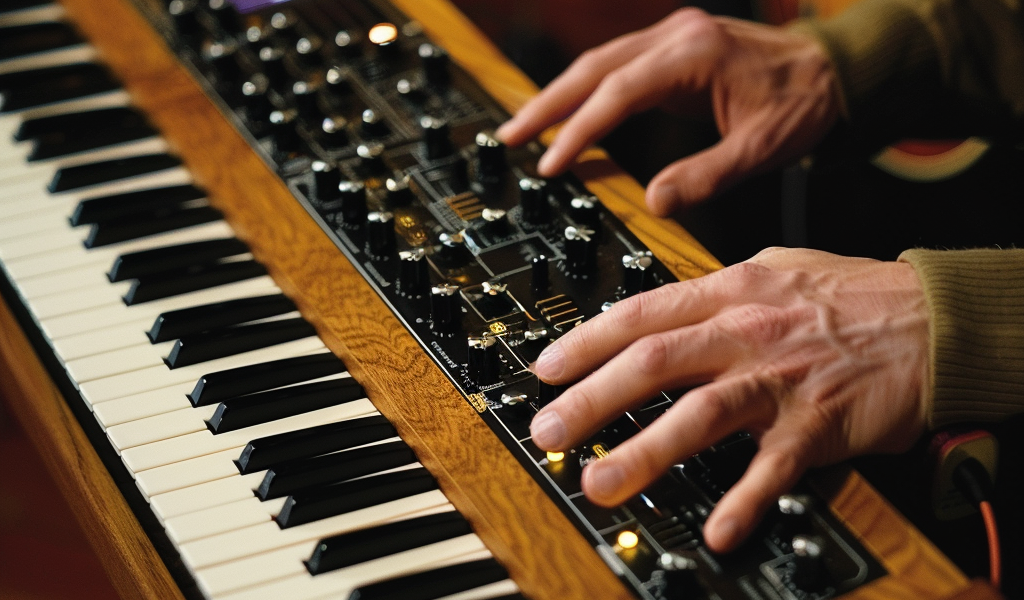Moog Music has officially unveiled its latest innovation, the Muse synthesizer, marking a significant addition to the world of analogue synthesis. This long-anticipated instrument has been the subject of speculation and excitement throughout the year, and now, with the full specifications confirmed, musicians and sound designers alike are eager to explore what the Muse has to offer.
Positioned as an eight-voice, bi-timbral synthesizer, the Muse features a 61-key semi-weighted keybed that is equipped with both velocity sensitivity and channel aftertouch. This allows for expressive playing that responds dynamically to the nuances of a musician’s touch. The Muse’s architecture is built upon Moog’s rich legacy, drawing inspiration from the iconic Moog Voyager, particularly in its dual analogue oscillators per voice.
The oscillators are designed to deliver a wide range of sonic possibilities, offering capabilities such as frequency modulation (FM), pulse-width modulation (PWM), and hard sync. Additionally, the Muse includes a modulation oscillator with selectable waveforms, providing further versatility in shaping sounds. This oscillator can be utilized to modulate various parameters, including filters, pitch, PWM, and voltage-controlled amplification (VCA).
One of the standout features of the Muse synthesizer is its dual per-voice ADSR envelopes, which allow for intricate control over the attack, decay, sustain, and release of sounds. Complementing this are dual analogue transistor ladder filters—one low-pass and one that can function as both low and high-pass filters. These filters can be routed in multiple configurations, including series, parallel, or stereo setups, giving users the flexibility to sculpt their sound in creative ways.
In addition to its oscillators and filters, the Muse is equipped with stereo voltage-controlled amplifiers (VCAs) that are based on Moog Modular circuits. These VCAs provide control over volume, pan position, and pan spread for each voice, further enhancing the instrument’s capabilities. The Muse also features a saturating mixer section that includes ring modulation, adding another layer of complexity to sound design.
For those who enjoy rhythmic and melodic programming, the Muse boasts a powerful arpeggiator and a 64-step sequencer. This sequencer offers both generative and probabilistic sequencing options, similar to the recently released Labyrinth, allowing musicians to create evolving patterns and intricate compositions.
With a competitive price point of $3,499, the Muse synthesizer stands out as an affordable alternative to other analogue polysynths on the market, such as the Arturia Polybrute 12, Oberheim OB-X8, and UDO Super Gemini. This pricing strategy makes high-quality synthesis more accessible to a broader range of musicians and producers.
For those interested in the technical specifications, the Muse synthesizer is packed with features designed to enhance the user experience. It includes a 61 full-size semi-weighted keybed that responds to velocity and channel aftertouch, along with various controllers such as a pitch wheel, modulation wheel, macro knob, and assignable pedal inputs for sustain and expression. The panel controls consist of 44 knobs, 16 sliders, and 129 buttons, all displayed on an OLED screen for clear visibility.
The analog voltage-controlled oscillators allow for a selectable triangle/sawtooth mix, variable width pulse wave, and octave settings ranging from 16’ to 2’. Musicians can also adjust the frequency within a +/- 7 semitone range and blend waveforms using the wave mix feature. The modulation oscillator offers a selection of waveforms, including sine, sawtooth, reverse sawtooth, square, and noise, with additional features for audio range toggling and keyboard tracking.
In summary, the Moog Muse synthesizer represents a significant advancement in analogue synthesis, combining classic Moog design with modern functionality. Its robust feature set, competitive pricing, and homage to Moog’s storied past make it a compelling choice for musicians seeking to push the boundaries of sound creation.





